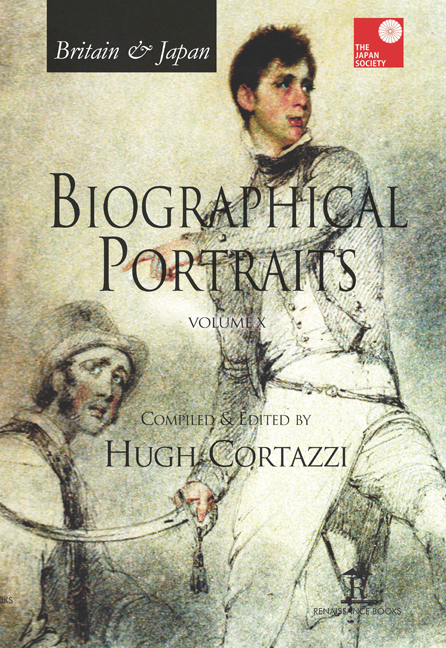Book contents
- Frontmatter
- Dedication
- Contents
- Introduction
- List of Contributors
- Index of Biographical Portraits in Japan Society Volumes
- PART I BRITAIN IN JAPAN
- PART II JAPAN IN BRITAIN
- Select Bibliography of Works in English on Anglo-Japanese Relations [Compiled by Gill Goddard – Retired East Asian Studies Librarian, University of Sheffield]
- Select Bibliography of Works in Japanese on Anglo-Japanese Relations [Compiled by Akira Hirano, SISJAC]
- Index
8 - No 48, Yokohama
Published online by Cambridge University Press: 07 May 2022
- Frontmatter
- Dedication
- Contents
- Introduction
- List of Contributors
- Index of Biographical Portraits in Japan Society Volumes
- PART I BRITAIN IN JAPAN
- PART II JAPAN IN BRITAIN
- Select Bibliography of Works in English on Anglo-Japanese Relations [Compiled by Gill Goddard – Retired East Asian Studies Librarian, University of Sheffield]
- Select Bibliography of Works in Japanese on Anglo-Japanese Relations [Compiled by Akira Hirano, SISJAC]
- Index
Summary
THE BUILDING
KANAGAWA PREFECTURE'S OLDEST surviving Western structure is the remnant of the ruined building, currently named Mollison Shokai or Mollison & Co., located at the corner of a block of land now called No. 54, which absorbed No. 48. It is a Kanagawa prefectural cultural asset with protected status. The Mollison in the Mollison Shokai name was James Pender Mollison who lived in No. 48 for many years from 1868 (see below).
There used to be two buildings at No. 48; what remains is part of the office but adjacent to it was a residence. The two buildings were the home and work place of a group of prominent Scottish businessmen who also played an important role in the sports scene in Yokohama for most of the second half of the nineteenth century.
In the dining room of the residence, the Yokohama Cricket Club (YCC) was founded in 1868 and No. 48 became the de facto ‘club house’ for the cricket club and other sports clubs before a pavilion was built on the cricket ground in Yokohama Park in 1877.
Towards the end of the nineteenth century, No. 48 became better known as the Japan office for Alfred Nobel's sales of dynamite than for its association with sports.
Today at Yamashitacho 54 in the old ‘foreign settlement’ area of Yokohama, just behind what used to be called Honcho Dori (main street), a huge modern theatre complex occupies what was originally designated in 1859 as several blocks of land and rented out to the first foreign merchants to come to Japan. On one corner a small strange single-storeyed structure sits awkwardly as if it had been abandoned for some reason after being half-demolished. There is no glass in its windows, no real floor and only a very basic roof. It looks as if it originally extended into the street and that the city's planners crazily built a major street over half of it. Indeed, they did just that not long after the 1923 earthquake.
A plaque on a piece of stone briefly declares that the building is a protected cultural asset. It is Kanagawa prefecture's oldest surviving Western structure and was built in 1883. Today its most attractive feature is the stone lintel that sits at the top of the arch of what is clearly the main entrance.
- Type
- Chapter
- Information
- Britain & Japan Biographical Portraits Vol X , pp. 98 - 105Publisher: Amsterdam University PressPrint publication year: 2016



